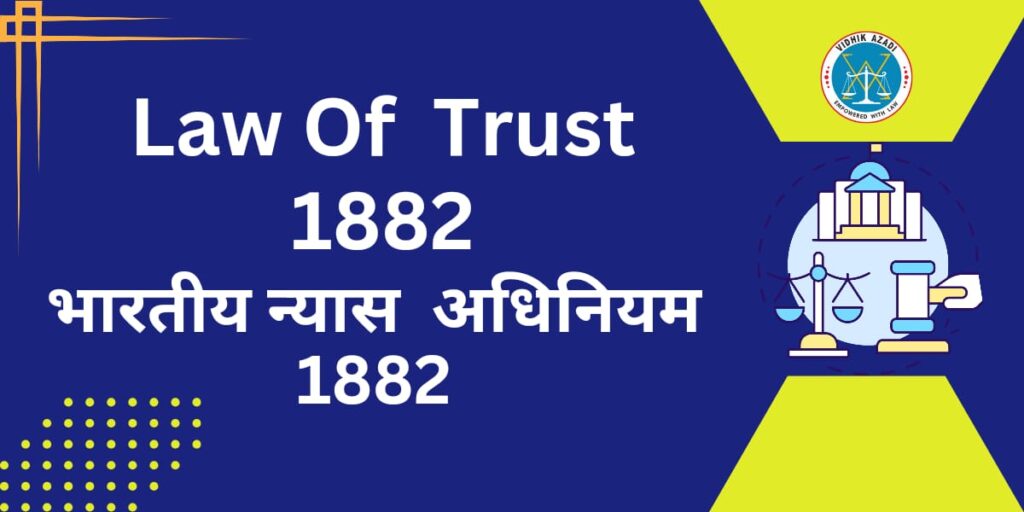Law of Trust

Law of Trust
The Law of Trusts in India is a crucial aspect of its legal framework, primarily governed by the Indian Trusts Act, 1882. Trusts in India are widely used for various purposes, including estate planning, charitable activities, and asset management. A trust is a legal arrangement in which the owner of the property (the settlor) transfers the property to another person (the trustee) to hold and manage for the benefit of a third person (the beneficiary). The Indian Trusts Act, 1882, provides the framework for the creation and management of private trusts in India.
The key elements are Settlor, Trustee, Beneficiary, Trust Property and Trust Deed. The duties of trustees are duty of care, duty of loyalty, duty of account, duty of invest and duty to distribute, whereas powers are power to sell and lease, power to invest, power to compromise. The rights of beneficiaries are right to information, right to income or principal and right to enforce the trust. The trust terminates when its purpose has been fulfilled. The trust may have a specified duration and terminate upon the expiry of that period. The trust may be revoked if the trust deed allows for revocation by the settlor. A court may order the termination of a trust under certain circumstances, such as impracticability or changes in law.
Trusts can protect assets from creditors and legal claims. Trusts facilitate the smooth transfer of assets upon death without the need for probate. Certain types of trusts offer tax advantages. Trusts allow the settlor to specify how and when beneficiaries receive benefits. Trusts are an effective way to support charitable causes. The Law of Trusts in India, primarily governed by the Indian Trusts Act, 1882, provides a comprehensive legal framework for the creation, management, and termination of trusts. Trusts are versatile legal instruments used for a variety of purposes, including asset management, estate planning, and charitable activities. Understanding the intricacies of trust law is essential for effective trust administration and ensuring that the interests of beneficiaries are safeguarded.
ट्रस्ट की विधि
भारत में ट्रस्ट की विधि एक महत्वपूर्ण कानूनी ढांचा है, जो मुख्य रूप से भारतीय ट्रस्ट अधिनियम, 1882 द्वारा शासित होता है। ट्रस्ट का उपयोग विभिन्न उद्देश्यों के लिए किया जाता है, जैसे संपत्ति योजना, धर्मार्थ गतिविधियाँ, और संपत्ति प्रबंधन। ट्रस्ट एक कानूनी व्यवस्था है जिसमें संपत्ति का मालिक (सेटलर) संपत्ति को किसी अन्य व्यक्ति (ट्रस्टी) को इस उद्देश्य से हस्तांतरित करता है कि वह इसे तीसरे व्यक्ति (लाभार्थी) के लाभ के लिए धारण और प्रबंधित करेगा। भारतीय ट्रस्ट अधिनियम, 1882, भारत में निजी ट्रस्टों के निर्माण और प्रबंधन के लिए ढांचा प्रदान करता है। ट्रस्ट के मुख्य तत्व सेटलर, ट्रस्टी, लाभार्थी, ट्रस्ट संपत्ति और ट्रस्ट डीड हैं। सेटलर को ट्रस्ट बनाने का स्पष्ट इरादा व्यक्त करना चाहिए। संपत्ति को ट्रस्टी को हस्तांतरित किया जाना चाहिए। ट्रस्ट का उद्देश्य कानूनी होना चाहिए। लाभार्थियों को स्पष्ट रूप से परिभाषित किया जाना चाहिए। ट्रस्ट डीड का निष्पादन किया जाना चाहिए, जिसमें ट्रस्ट की शर्तें विवरण में हों।
ट्रस्टी को उचित सावधानी और कौशल के साथ ट्रस्ट संपत्ति का प्रबंधन करना चाहिए। ट्रस्टी को लाभार्थियों के सर्वोत्तम हित में कार्य करना चाहिए। ट्रस्टी को सटीक लेखा रखना चाहिए और लाभार्थियों को जानकारी प्रदान करनी चाहिए। ट्रस्टी को ट्रस्ट संपत्ति को सावधानीपूर्वक निवेश करना चाहिए। ट्रस्टी को ट्रस्ट डीड के अनुसार ट्रस्ट संपत्ति का वितरण करना चाहिए। ट्रस्टी ट्रस्ट संपत्ति को बेच या पट्टे पर दे सकते हैं यदि ट्रस्ट डीड द्वारा अनुमत हो। ट्रस्टी ट्रस्ट संपत्ति को उपयुक्त प्रतिभूतियों में निवेश कर सकते हैं। ट्रस्टी ट्रस्ट से संबंधित दावों को समझौता या निपटान कर सकते हैं। लाभार्थियों को ट्रस्ट और उसके प्रबंधन के बारे में जानकारी का अधिकार है। लाभार्थियों को ट्रस्ट डीड में निर्दिष्ट अनुसार वितरण प्राप्त करने का अधिकार है। यदि ट्रस्टी अपने कर्तव्यों का उल्लंघन करते हैं तो लाभार्थी कानूनी कार्रवाई कर सकते हैं।
जब ट्रस्ट का उद्देश्य पूरा हो जाता है तो ट्रस्ट समाप्त हो जाता है। ट्रस्ट की एक निर्दिष्ट अवधि हो सकती है और उस अवधि के समाप्त होने पर समाप्त हो जाता है। ट्रस्ट को रद्द किया जा सकता है यदि ट्रस्ट डीड द्वारा सेटलर को रद्दीकरण की अनुमति दी गई हो। कुछ परिस्थितियों में, जैसे कि अप्रासंगिकता या कानूनी परिवर्तनों के कारण, अदालत ट्रस्ट को समाप्त करने का आदेश दे सकती है। भारत में ट्रस्ट की विधि, मुख्य रूप से भारतीय ट्रस्ट अधिनियम, 1882 द्वारा शासित, ट्रस्ट के निर्माण, प्रबंधन और समाप्ति के लिए एक व्यापक कानूनी ढांचा प्रदान करती है। ट्रस्ट विभिन्न उद्देश्यों के लिए उपयोग किए जाते हैं, जिनमें संपत्ति प्रबंधन, संपत्ति योजना और धर्मार्थ गतिविधियाँ शामिल हैं। ट्रस्ट विधि की जटिलताओं को समझना प्रभावी ट्रस्ट प्रशासन और लाभार्थियों के हितों की सुरक्षा सुनिश्चित करने के लिए आवश्यक है।
